英国文学复习资料
- 格式:doc
- 大小:83.50 KB
- 文档页数:26
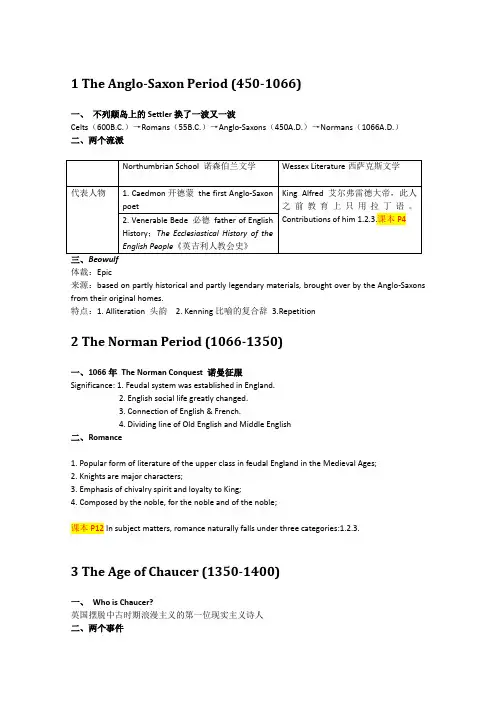
1 The Anglo-Saxon Period (450-1066)一、不列颠岛上的Settler换了一波又一波Celts(600B.C.)→Romans(55B.C.)→Anglo-Saxons(450A.D.)→Normans(1066A.D.)二、两个流派体裁:Epic来源:based on partly historical and partly legendary materials, brought over by the Anglo-Saxons from their original homes.特点:1. Alliteration 头韵 2. Kenning比喻的复合辞3.Repetition2 The Norman Period (1066-1350)一、1066年The Norman Conquest 诺曼征服Significance: 1. Feudal system was established in England.2. English social life greatly changed.3. Connection of English & French.4. Dividing line of Old English and Middle English二、Romance1. Popular form of literature of the upper class in feudal England in the Medieval Ages;2. Knights are major characters;3. Emphasis of chivalry spirit and loyalty to King;4. Composed by the noble, for the noble and of the noble;课本P12 In subject matters, romance naturally falls under three categories:1.2.3.3 The Age of Chaucer (1350-1400)一、Who is Chaucer?英国摆脱中古时期浪漫主义的第一位现实主义诗人二、两个事件1. The Hundred Years War 百年战争(英VS法)2. The Peasant Uprising of 1381 (打仗没钱了管peasant要,于是peasant揭竿而起)三、John Wycliff1. He was the major person who translated Bible into Middle English, which is important to English Literature and English Language2. He fixed a national standard for English prose to replace various dialects. His works earned him the title of Father of English prose. 普通话第一人四、Geoffery Chaucer 乔叟1. The works of Chaucer are roughly divided into 3 periods 课本P182. The significance of The Canterbury Tales is as follows 课本P194 The Fifteenth Century (1400-1550)一、两个战争和两个事件1. The Hundred Years’ War 百年战争1337 - 14532. The War of the Roses 玫瑰战争1455-14853. The discovery of America and the new sea routes4. Reformation of the Church二、Popular ballads民谣是这一时期主要体裁1. five basic characteristics 课本P362. 重要作品Robin Hood Ballads 侠盗罗宾汉5 The English Renaissance (1550-1642)一、英国文艺复兴时期在位的女王是Queen Elizabeth (1558-1603) 伊丽莎白一世二、思想:Humanism (Man is the measure of all things)1. It was against human nature to sacrifice the happiness of this life for an after life; the pursuit of this life.2. Man should be given full freedom to enrich their intellectual and emotional life.三、Edmund Spenser是英国文艺复兴时期的伟大诗人四、英国文艺复兴时期的主流文学形式是Drama6 The Seventeenth Century (1603-1688)一、Key words of period of Revolution and RestorationBourgeois 资产阶级Anglican Church 英国国教Puritans 清教徒Charles I 查理一世1641年Grand Remonstrance 大抗议书Commonwealth 英联邦Cromwell in 1653 the Lord Protector 护国公克伦威尔The Bill of Rights 权利法案二、King James Version of the Bible(钦定版圣经),是《圣经》的诸多英文版本之一,于1611年出版。
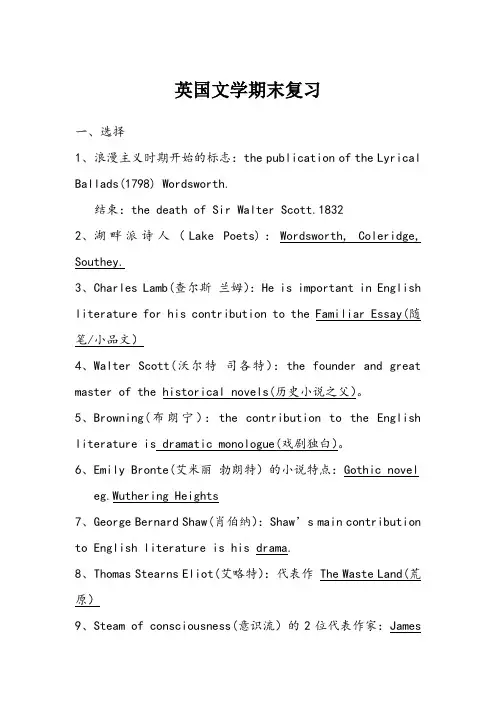
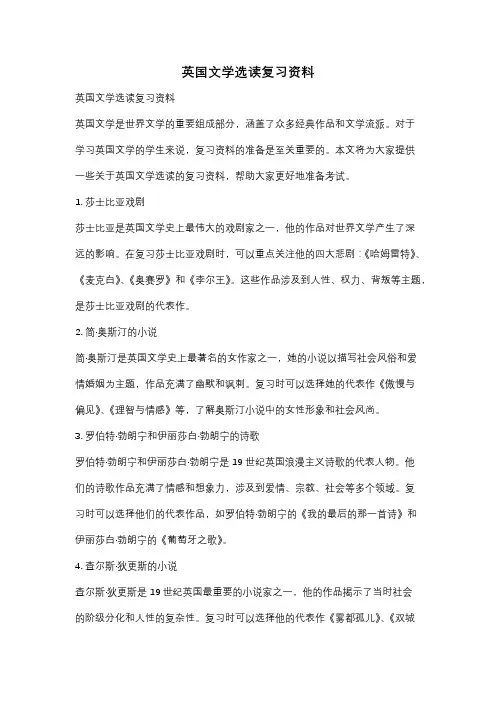
英国文学选读复习资料英国文学选读复习资料英国文学是世界文学的重要组成部分,涵盖了众多经典作品和文学流派。
对于学习英国文学的学生来说,复习资料的准备是至关重要的。
本文将为大家提供一些关于英国文学选读的复习资料,帮助大家更好地准备考试。
1. 莎士比亚戏剧莎士比亚是英国文学史上最伟大的戏剧家之一,他的作品对世界文学产生了深远的影响。
在复习莎士比亚戏剧时,可以重点关注他的四大悲剧:《哈姆雷特》、《麦克白》、《奥赛罗》和《李尔王》。
这些作品涉及到人性、权力、背叛等主题,是莎士比亚戏剧的代表作。
2. 简·奥斯汀的小说简·奥斯汀是英国文学史上最著名的女作家之一,她的小说以描写社会风俗和爱情婚姻为主题,作品充满了幽默和讽刺。
复习时可以选择她的代表作《傲慢与偏见》、《理智与情感》等,了解奥斯汀小说中的女性形象和社会风尚。
3. 罗伯特·勃朗宁和伊丽莎白·勃朗宁的诗歌罗伯特·勃朗宁和伊丽莎白·勃朗宁是19世纪英国浪漫主义诗歌的代表人物。
他们的诗歌作品充满了情感和想象力,涉及到爱情、宗教、社会等多个领域。
复习时可以选择他们的代表作品,如罗伯特·勃朗宁的《我的最后的那一首诗》和伊丽莎白·勃朗宁的《葡萄牙之歌》。
4. 查尔斯·狄更斯的小说查尔斯·狄更斯是19世纪英国最重要的小说家之一,他的作品揭示了当时社会的阶级分化和人性的复杂性。
复习时可以选择他的代表作《雾都孤儿》、《双城记》等,了解狄更斯小说中的社会批判和人道主义思想。
5. 威廉·莎士比亚的诗歌除了戏剧作品,莎士比亚还有许多优秀的诗歌作品。
他的诗歌涉及到爱情、自然、时间等主题,语言优美、意境深远。
复习时可以选择他的一些著名sonnet,如《十四行诗集》中的第18首和第130首,了解莎士比亚诗歌的特点和主题。
6. 珍·奥斯汀的小说珍·奥斯汀是19世纪英国最重要的女作家之一,她的小说以描写女性生活和婚姻为主题,作品充满了幽默和洞察力。
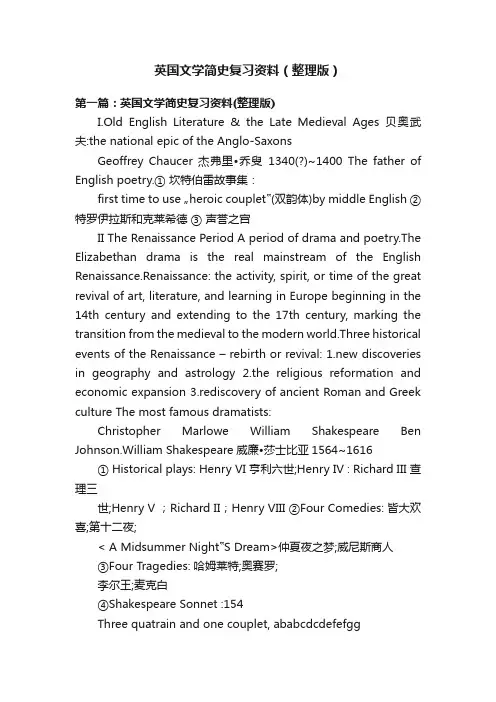
英国文学简史复习资料(整理版)第一篇:英国文学简史复习资料(整理版)I.Old English Literature & the Late Medieval Ages 贝奥武夫:the national epic of the Anglo-SaxonsGeoffrey Chaucer 杰弗里•乔叟1340(?)~1400 The father of English poetry.① 坎特伯雷故事集:first time to use …heroic couplet‟(双韵体)by middle English ②特罗伊拉斯和克莱希德③ 声誉之宫II The Renaissance Period A period of drama and poetry.The Elizabethan drama is the real mainstream of the English Renaissance.Renaissance: the activity, spirit, or time of the great revival of art, literature, and learning in Europe beginning in the 14th century and extending to the 17th century, marking the transition from the medieval to the modern world.Three historical events of the Renaissance – rebirth or revival: 1.new discoveries in geography and astrology 2.the religious reformation and economic expansion 3.rediscovery of ancient Roman and Greek culture The most famous dramatists:Christopher Marlowe William Shakespeare Ben Johnson.William Shakespeare威廉•莎士比亚1564~1616① Historical plays: Henry VI 亨利六世;Henry IV : Richard III 查理三世;Henry V ;Richard II;Henry VIII ②Four Comedies: 皆大欢喜;第十二夜;< A Midsummer Night‟S Dream>仲夏夜之梦;威尼斯商人③Four Tragedies: 哈姆莱特;奥赛罗;李尔王;麦克白④Shakespeare Sonnet :154Three quatrain and one couplet, ababcdcdefefggA sonnet is a lyric consisting of 14 lines, usually iniambic pentameter restricted to a definition rhyme scheme.⑤the comedy of errors 错中错,Titus Andronicus泰特斯·安特洛尼克斯,The Taming of the shrew 驯悍记Love's labour's lost(爱的徒劳)Romeo and Juliet 罗密欧与朱丽叶Much ado about nothing(无事生非)The merry wives of Windsor.温莎的风流娘们King John 约翰王All's well that ends well 终成眷属Measure for measure(一报还一报)Bacon: Of Studies;Of Beauty;Of Marriage and Single Life English Bourgeois Revolution,学术的推进 III:the period of the English bourgeois ton:1608~1674Paradise Lost;Samson Agonistes(力士参孙);On the morning of Christ’s Nativity,复乐园我的失明论出版自由为英国人民声辩Bunyan: 1628~1688 ①Religionary Allegory:天路历程Grace Abounding to the Chief of Sinner;the Holy War John Don: the Metaphysical poet(玄学派诗人).Metaphysical Poetry(玄学诗):(用语)the diction is simple, the imagery is from the actual,(形式)the form is frequently an argument with the poet’s beloved, with god, or with himself.(主题:love, religious, thought)The Flea;跳蚤Forbbiding Mourning,Songs And Sonnets歌与十四行诗,emergent occasions 突变引起的诚念Hely sonnets IV The 18th Century:EnlightenmentA revival of interest in the old classical works, order, logic, restrained emotion(抑制情感)and accuracy The Age ofEnlightenment/Reason: the movement was a furtherance of the Renaissance of the 15th and 16th centries, a progressive intellectual movement, reason(rationality), equality&science(the 18th century)小说崛起:In the mid-century, the newly literary form, modern English novel rised(realistic novel现实主义小说)Gothic novel(哥特式小说):mystery, horror, castles(from middle part to the end of century)Jonathan Swift乔纳森•斯威夫特1667~1745(十八世纪杰出的政论家和讽刺小说家 a master satirist。
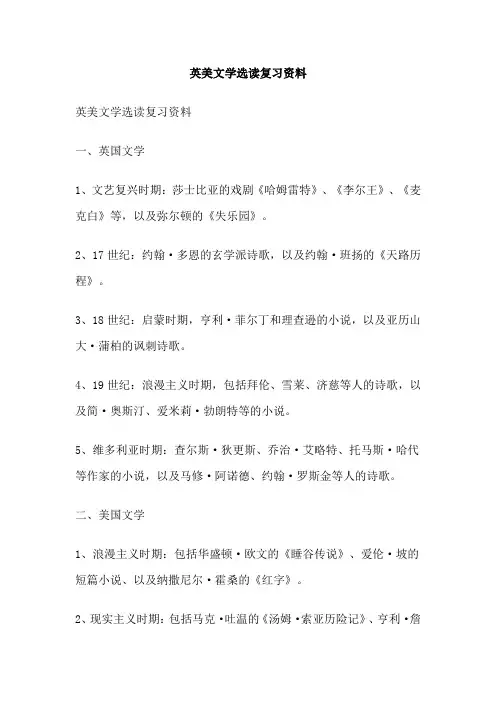
英美文学选读复习资料英美文学选读复习资料一、英国文学1、文艺复兴时期:莎士比亚的戏剧《哈姆雷特》、《李尔王》、《麦克白》等,以及弥尔顿的《失乐园》。
2、17世纪:约翰·多恩的玄学派诗歌,以及约翰·班扬的《天路历程》。
3、18世纪:启蒙时期,亨利·菲尔丁和理查逊的小说,以及亚历山大·蒲柏的讽刺诗歌。
4、19世纪:浪漫主义时期,包括拜伦、雪莱、济慈等人的诗歌,以及简·奥斯汀、爱米莉·勃朗特等的小说。
5、维多利亚时期:查尔斯·狄更斯、乔治·艾略特、托马斯·哈代等作家的小说,以及马修·阿诺德、约翰·罗斯金等人的诗歌。
二、美国文学1、浪漫主义时期:包括华盛顿·欧文的《睡谷传说》、爱伦·坡的短篇小说、以及纳撒尼尔·霍桑的《红字》。
2、现实主义时期:包括马克·吐温的《汤姆·索亚历险记》、亨利·詹姆斯的小说、以及艾米莉·狄金森的诗歌。
3、20世纪:包括F.斯科特·菲茨杰拉德的《了不起的盖茨比》、欧内斯特·海明威的《老人与海》、杰克·凯鲁亚克的《在路上》等文学作品。
三、文学术语和概念1、象征主义:通过象征性的符号或形象来表达某种思想或情感。
2、叙事视角:从特定的角度来描述故事,常见的有第一人称、第二人称、第三人称等。
3、意象主义:通过形象和比喻来表达情感和思想。
4、文艺复兴:欧洲历史上的一次文化运动,强调人文主义和古希腊罗马文化。
5、玄学派:17世纪英国的一种文学流派,强调诗歌中的哲学思考和神秘主义。
6、悲剧:一种戏剧类型,通常表现英雄人物的悲惨命运。
7、喜剧:一种戏剧类型,通常表现幽默、讽刺等轻松愉快的主题。
8、自然主义:一种文学流派,强调对自然和社会现实的客观描写。
9、超验主义:一种哲学思想,强调个人经验和直觉,反对传统权威。
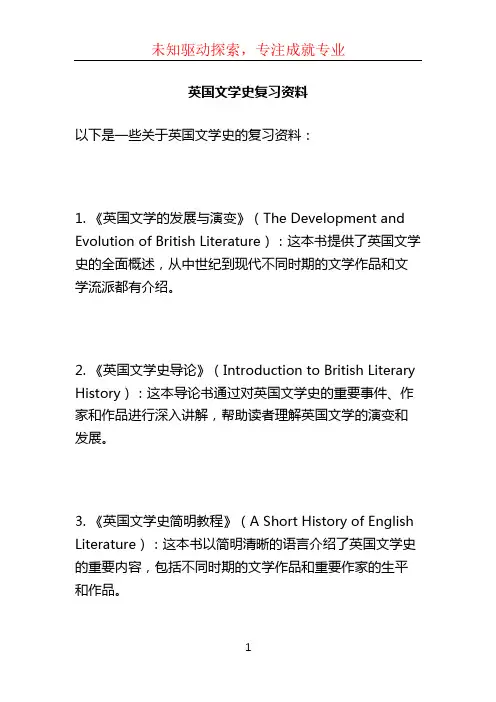
英国文学史复习资料
以下是一些关于英国文学史的复习资料:
1. 《英国文学的发展与演变》(The Development and Evolution of British Literature):这本书提供了英国文学史的全面概述,从中世纪到现代不同时期的文学作品和文学流派都有介绍。
2. 《英国文学史导论》(Introduction to British Literary History):这本导论书通过对英国文学史的重要事件、作家和作品进行深入讲解,帮助读者理解英国文学的演变和发展。
3. 《英国文学史简明教程》(A Short History of English Literature):这本书以简明清晰的语言介绍了英国文学史的重要内容,包括不同时期的文学作品和重要作家的生平和作品。
4. 网络资源:有许多网站提供关于英国文学史的资料和学
术文章,如英国文学史学术网站、大学的文学部门网站等。
你可以在搜索引擎上搜索英国文学史相关的关键词,找到
适合你的学习资料。
5. 学术论文和专著:在学术期刊和图书馆中,你可以找到
许多针对英国文学史的研究论文和专著,这些都是深入了
解英国文学史的重要资源。
无论使用哪种资料,重要的是要有系统地学习和复习英国
文学史,理解各个时期的文学作品和文学流派的特点和发
展趋势,同时熟悉一些重要的作家和作品。
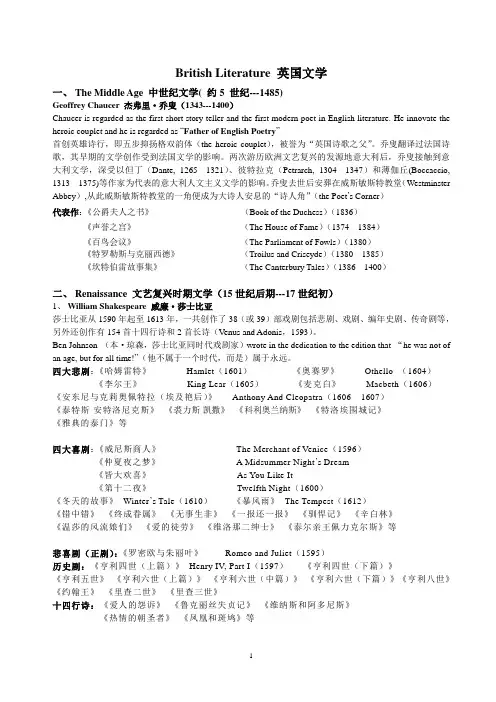
British Literature 英国文学一、The Middle Age 中世纪文学( 约5 世纪---1485)Geoffrey Chaucer 杰弗里·乔叟(1343---1400)Chaucer is regarded as the first short story teller and the first modern poet in English literature. He innovate the heroic couplet and he is regarded as “Father of English Poetry”首创英雄诗行,即五步抑扬格双韵体(the heroic couplet),被誉为“英国诗歌之父”。
乔叟翻译过法国诗歌,其早期的文学创作受到法国文学的影响。
两次游历欧洲文艺复兴的发源地意大利后,乔叟接触到意大利文学,深受以但丁(Dante, 1265---1321)、彼特拉克(Petrarch, 1304---1347)和薄伽丘(Boccaccio, 1313---1375)等作家为代表的意大利人文主义文学的影响。
乔叟去世后安葬在威斯敏斯特教堂(Westminster Abbey),从此威斯敏斯特教堂的一角便成为大诗人安息的“诗人角”(the Poet’s Corner)代表作:《公爵夫人之书》(Book of the Duchess)(1836)《声誉之宫》(The House of Fame)(1374---1384)《百鸟会议》(The Parliament of Fowls)(1380)《特罗勒斯与克丽西德》(Troilus and Criseyde)(1380---1385)《坎特伯雷故事集》(The Canterbury Tales)(1386---1400)二、Renaissance 文艺复兴时期文学(15世纪后期---17世纪初)1、William Shakespeare 威廉·莎士比亚莎士比亚从1590年起至1613年,一共创作了38(或39)部戏剧包括悲剧、戏剧、编年史剧、传奇剧等,另外还创作有154首十四行诗和2首长诗(Venus and Adonis,1593)。
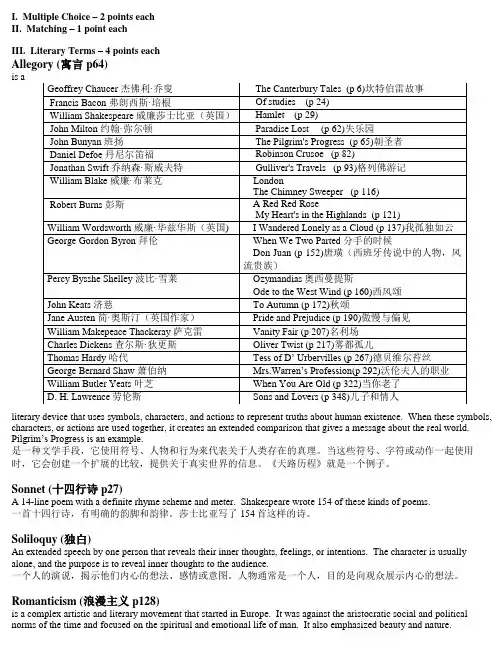
I. Multiple Choice – 2 points eachII. Matching – 1 point eachIII. Literary Terms – 4 points eachAllegory (寓言p64)is aliterary device that uses symbols, characters, and actions to represent truths about human existence. When these symbols, characters, or actions are used together, it creates an extended comparison that gives a message about the real world. Pilgrim’s Progress is an example.是一种文学手段,它使用符号、人物和行为来代表关于人类存在的真理。
当这些符号、字符或动作一起使用时,它会创建一个扩展的比较,提供关于真实世界的信息。
《天路历程》就是一个例子。
Sonnet (十四行诗 p27)A 14-line poem with a definite rhyme scheme and meter. Shakespeare wrote 154 of these kinds of poems.一首十四行诗,有明确的韵脚和韵律。
莎士比亚写了154首这样的诗。
Soliloquy (独白)An extended speech by one person that reveals their inner thoughts, feelings, or intentions. The character is usually alone, and the purpose is to reveal inner thoughts to the audience.一个人的演说,揭示他们内心的想法、感情或意图。
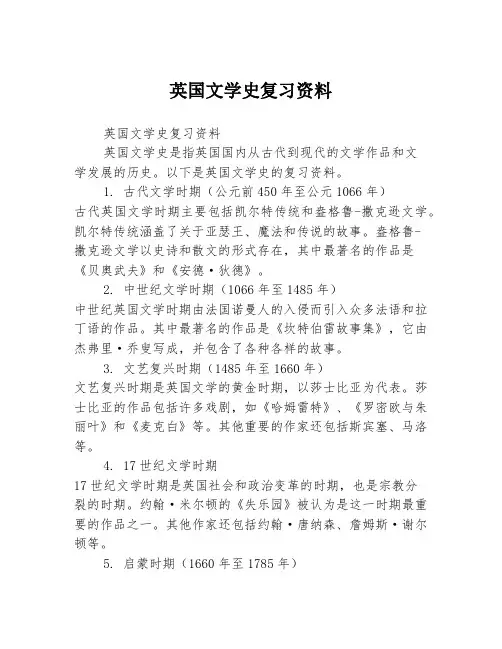
英国文学史复习资料英国文学史复习资料英国文学史是指英国国内从古代到现代的文学作品和文学发展的历史。
以下是英国文学史的复习资料。
1. 古代文学时期(公元前450年至公元1066年)古代英国文学时期主要包括凯尔特传统和盎格鲁-撒克逊文学。
凯尔特传统涵盖了关于亚瑟王、魔法和传说的故事。
盎格鲁-撒克逊文学以史诗和散文的形式存在,其中最著名的作品是《贝奥武夫》和《安德·狄德》。
2. 中世纪文学时期(1066年至1485年)中世纪英国文学时期由法国诺曼人的入侵而引入众多法语和拉丁语的作品。
其中最著名的作品是《坎特伯雷故事集》,它由杰弗里·乔叟写成,并包含了各种各样的故事。
3. 文艺复兴时期(1485年至1660年)文艺复兴时期是英国文学的黄金时期,以莎士比亚为代表。
莎士比亚的作品包括许多戏剧,如《哈姆雷特》、《罗密欧与朱丽叶》和《麦克白》等。
其他重要的作家还包括斯宾塞、马洛等。
4. 17世纪文学时期17世纪文学时期是英国社会和政治变革的时期,也是宗教分裂的时期。
约翰·米尔顿的《失乐园》被认为是这一时期最重要的作品之一。
其他作家还包括约翰·唐纳森、詹姆斯·谢尔顿等。
5. 启蒙时期(1660年至1785年)启蒙时期是英国文学史上的一次重要转折点,代表了对理性、科学和自由思想的追求。
著名作家包括强纳森·斯威夫特、丹尼尔·笛福、亚历山大·蒲柏、简·奥斯汀等。
6. 浪漫主义时期(1785年至1837年)浪漫主义时期是对启蒙时期理性主义的反应。
浪漫主义作品强调情感、个人主义和自然。
威廉·华兹华斯、塞缪尔·柯勒律治、约翰·济慈等都是这一时期的重要作家。
7. 维多利亚时代(1837年至1901年)维多利亚时代是英国帝国的鼎盛时期,文学作品多样化。
查尔斯·狄更斯的《雾都孤儿》、古斯塔夫·福楼拜的《名利场》等作品成为经典。
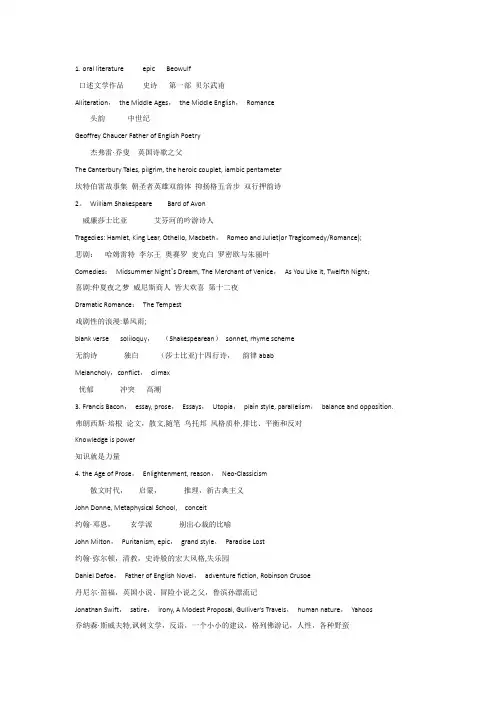
1.oral literature epic Beowulf口述文学作品史诗第一部贝尔武甫Alliteration,the Middle Ages,the Middle English,Romance头韵中世纪Geoffrey Chaucer Father of English Poetry杰弗雷·乔叟英国诗歌之父The Canterbury Tales, pilgrim, the heroic couplet, iambic pentameter坎特伯雷故事集朝圣者英雄双韵体抑扬格五音步双行押韵诗2。
William Shakespeare Bard of Avon威廉莎士比亚艾芬河的吟游诗人Tragedies: Hamlet, King Lear, Othello, Macbeth,Romeo and Juliet(or Tragicomedy/Romance);悲剧:哈姆雷特李尔王奥赛罗麦克白罗密欧与朱丽叶Comedies:Midsummer Night’s Dream, The Merchant of Venice,As You Like It, Twelfth Night;喜剧:仲夏夜之梦威尼斯商人皆大欢喜第十二夜Dramatic Romance:The Tempest戏剧性的浪漫:暴风雨;blank verse soliloquy,(Shakespearean)sonnet, rhyme scheme无韵诗独白(莎士比亚)十四行诗,韵律ababMelancholy,conflict,climax忧郁冲突高潮3.Francis Bacon,essay, prose,Essays,Utopia,plain style, parallelism,balance and opposition. 弗朗西斯·培根论文,散文,随笔乌托邦风格质朴,排比、平衡和反对Knowledge is power知识就是力量4. the Age of Prose,Enlightenment, reason,Neo-Classicism散文时代,启蒙,推理,新古典主义John Donne, Metaphysical School, conceit约翰·邓恩,玄学派别出心裁的比喻John Milton,Puritanism, epic,grand style,Paradise Lost约翰·弥尔顿,清教,史诗般的宏大风格,失乐园Daniel Defoe,Father of English Novel,adventure fiction, Robinson Crusoe丹尼尔·笛福,英国小说、冒险小说之父,鲁滨孙漂流记Jonathan Swift,satire,irony, A Modest Proposal, Gulliver's Travels,human nature,Yahoos乔纳森·斯威夫特,讽刺文学,反语,一个小小的建议,格列佛游记,人性,各种野蛮5。
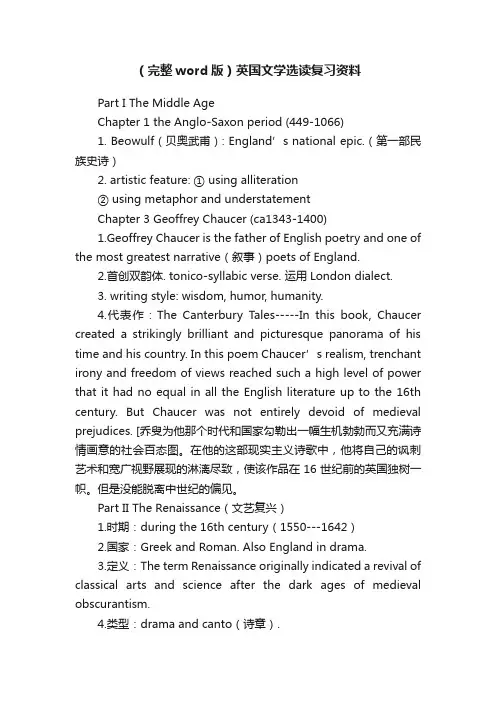
(完整word版)英国文学选读复习资料Part I The Middle AgeChapter 1 the Anglo-Saxon period (449-1066)1. Beowulf(贝奥武甫): England’s national epic.(第一部民族史诗)2. artistic feature: ① using alliteration② using metaphor and understatementChapter 3 Geoffrey Chaucer (ca1343-1400)1.Geoffrey Chaucer is the father of English poetry and one of the most greatest narrative(叙事)poets of England.2.首创双韵体. tonico-syllabic verse. 运用London dialect.3. writing style: wisdom, humor, humanity.4.代表作:The Canterbury Tales-----In this book, Chaucer created a strikingly brilliant and picturesque panorama of his time and his country. In this poem Chaucer’s realism, trenchant irony and freedom of views reached such a high level of power that it had no equal in all the English literature up to the 16th century. But Chaucer was not entirely devoid of medieval prejudices. [乔叟为他那个时代和国家勾勒出一幅生机勃勃而又充满诗情画意的社会百态图。
English Literature• 1. 中世纪文学/mediaeval literature(约5世纪—1485)• 2. 文艺复兴时期文学/Renaissance literature(15世纪后期—17世纪初)• 3. 17世纪文学/17th Century Literature• 4. 启蒙时期文学/Literature Enlightenment period(17世纪后期—18世纪中期)• 5. 浪漫主义时期文学/Romantic literature period(1798-1832)• 6. 现实主义时期文学/Realism period(19世纪30年代-1918)•7. 现代主义文学时期/Modern Literature period (1918-1945)•8. 当代文学/Contemporary Literature(1945—今)1. 中世纪文学/mediaeval literature(约5世纪—1485)Note:“Medieval period” is a quite special period in English history. In Chinese “Medieval” or “The Middle Age”. Overview:•Many books on English literature begin with Chaucer, who serves as a convenient starting point since he is undoubtedly the first important writer in English history. Such a convenient choice, however, will leave out Beowulf, the most impressive long poem in Old English.•From the history ,the land was occupied by the Celts 凯尔特人before the Romans invaded it.Part I: Anglo-Saxon Period (449—1066)1. Historical background2. literature3. Old English Poetry: BeowulfThe Anglo-Saxon period (449-1066)•English literature began with the Anglo-Saxon settlement• 1. historical background•Three conquests: Roman conquest in 43 AD; Anglo-Saxon conquest in 449; Norman conquest in 1066 •43 AD, Roman conquered Britain ,making the latter a province of Roman Empire; the withdrawal of Roman troops ,the Teutonic tribes日耳曼人的,条顿人的.•esp., the Anglos conquered the island and called it Angle-land, then England, their language is Anglo-Saxon old English.New words:•pagan [‘peiɡən]:异教徒, 非基督教徒•Saga ['sɑ:ɡə]:中世纪北欧传说; 英雄传奇(saga novel)(多卷本)家世小说•ecclesiastic [i͵kli:zi'æstik] :(基督教的)牧师, 教士2. Literature:•the old English poetry can be divided into two groups: the secular and the religious.•The secular group: Beowulf, The Wife’s Complaints•The religious group: Genesis A and B are two poems based on the Old Testament.Sum up: 2. literature•1): pagan: oral sagas--the Song of Beowulf•2): Christian: copied by the monk.•The influence of the Christianity upon language and culture.•Two ecclesiastic poets: Caedmon and Cynewulf•Caedmon--[‘kædmən]凯德蒙(公元7世纪盎格鲁-撒克逊基督教诗人)•Cynewulf--[‘kinəwulf] 基涅武甫(盎格鲁-撒克逊诗人,生活在公元9 世纪诺森伯里亚或麦西亚,其古英语诗稿于10世纪被发现,有《埃琳娜》、《使徒们的命运》、《基督升天》和《朱莉安娜》等) Epic:史诗•Epic is an extended narrative poem in elevated or dignified language and in a grand style, like Homer’sIliad[‘iliəd] and Odyssey[’ɔdisi] . It usually celebrates the feats and achievements of one or more legendary or traditional heroes. The action is simple but full of magnificence. Many epics were drawn from an oral tradition and were transmitted by song and recitation before they were written down.•The epics are the earliest pieces of literature surviving from the Old English period and indeed a tribute to the vitality of the ancient paganism. This tradition is the composing in verse of tribal or national legends about a great hero, always a fighting warrior.•This is to be found in the Heroic Age of the Anglo-Saxons, while they were still on the Continent. In any case, the personality and the deeds of a hero were a source of inspiration to members of the tribe. To celebrate the deeds of the hero, and thereby to perpetuate his name and his glory unto succeeding generations, was the business of the bard, or minstrel, whom the Anglo-Saxons called the scop古代盎格鲁撒克逊的(吟游)诗人or gleeman吟游诗人.•How many of these epics were composed during the Heroic Age of the Anglo-Saxon can not be told;none of them were written down for centuries; instead they were passed by word of mouth from scop to scop; and the stories grew in the passing.•the Song of Beowulf [‘beɪə、wʊlf]----England’s national epicOld English Poetry: The Story of Beowulf•Beowulf -- written in 10th century, probably composed some time during the first half of the 8th century, after the Christianization of the whole nation. The historical event described in the poem belongs to the early 6th century.•Beowulf is the national epic of the Anglo-Saxon and English people. It consists of 3182 lines and is to be divided into two parts.–Though it is regarded today as the national epic of the Anglo-Saxons, th e hero and the setting of Beowulf have nothing to do with England, for the story took place in Scandinavia .•Scandinavia --[skændɪ’neɪvɪə]:the countries of N Europe, esp. considered as a cultural unit and including Norway, Sweden, Denmark, and often Finland, Iceland, and the Faeroes斯堪的纳维亚(半岛)(欧洲)Beowulf•Beowulf is folk legend brought to England by the Anglo-Saxons from their continental homes. Beowulf isa grand hero. He is so, simply by his deeds. He is faithful to his people. He goes alone, in a strange land,to venture himself for the deliverance of his people. He forgets himself in face of death. Though the poem was written in the 10th century, its hero was no doubt mainly the product of a primitive, tribal society on the continent.2). the Song of Beowulf- plot and theme:I. a. fight with Grendel II. a. fight with fire dragonb. fight with Grendel’s mother b. death and funeralplot•Part I: It opens in Denmark, where King Hrothgar's splendid mead hall, Heorot, has been ravaged for 12 years by nightly visits from an evil monster, Grendel, who carries off Hrothgar's warriors and devours them. Unexpectedly, young Beowulf, a prince of the Geats of southern Sweden, arrives with a small band of retainers and offers to cleanse Heorot of its monster. The King is astonished at the little-known hero's daring but welcomes him, and after an evening of feasting, much courtesy, and some discourtesy, the King retires, leaving Beowulf in charge. During the night Grendel comes from the moors, tears open the heavy doors, and devours one of the sleeping Geats. He then grapples with Beowulf, whose powerful grip he cannot escape. He wrenches himself free, tearing off his arm, and leaves, mortally wounded.•The next day is one of rejoicing in Heorot. But at night as the warriors sleep, Grendel's mother comes toavenge her son, killing one of Hrothgar's men. In the morning Beowulf seeks her out in her cave at the bottom of a mere and kills her. He cuts the head from Grendel's corpse and returns to Heorot. The Danes rejoice once more. Hrothgar makes a farewell speech about the character of the true hero, as Beowulf, enriched with honors and princely gifts, returns home to King Hygelac of the Geats.•The second part passes rapidly over King Hygelac's subsequent death in a battle (of historical record), the death of his son, and Beowulf's succession to the kingship and his peaceful rule of 50 years. But now a fire-breathing dragon ravages his land and the doughty but aging Beowulf engages it. The fight is long and terrible and a painful contrast to the battles of his youth. Painful, too, is the desertion of his retainers except for his young kinsman Wiglaf. Beowulf kills the dragon but is mortally wounded. The poem ends with his funeral rites and a lament.基本情节可分为两部分:•第一部分(诗行1—1904):丹麦国王赫罗斯加兴建了一座宏伟的宴乐厅,遭到魔怪格兰道尔的袭击。
British Writers and WorksI. Old English Literature & The Late Medieval Ages<Beowulf>贝奥武夫:the national epic of the Anglo-SaxonsEpic: long narrative poems that record the adventures or heroic deeds of a hero en acted in vast landscapes. The style of epic is grand and elevated.e.g. Homer’s Iliad and OdysseyArtistic features:ing alliterationDefinition of alliteration: a rhetorical device, meaning some words ina sentence begin with the same consonant sound (头韵)Some examples on P5ing metaphor and understatementDefinition of understatement: expressing something in a controlled wayUnderstatement is a typical way for Englishmen to express their ideasGeoffery Chaucer 杰弗里•乔叟 1340(?)~1400(首创“双韵体”,英国文学史上首先用伦敦方言写作。
约翰· 德莱顿(John Dryden) 称其为“英国诗歌之父”。
代表作《坎特伯雷故事集》。
)The father of English poetry.writing style: wisdom, humor, humanity.① <The Canterbury Tale s>坎特伯雷故事集:first time to use ‘heroic couplet’(双韵体) by middle English②<Troilus and Criseyde>特罗伊拉斯和克莱希德③ <The House of Fame>声誉之宫Medieval Ages’popular Literary form: Romance(传奇故事)Famous three: King ArthurSir Gawain and the Green KnightBeowulfII The Renaissance PeriodA period of drama and poetry. The Elizabethan drama is the real mainstreamof the English Renaissance.Renaissance : the activity, spirit, or time of the great revival of art, literature, and learning in Europe beginning in the 14th century and extending to the 17th century, marking the transition from the medieval to the modern world.Three historical events of the Renaissance –rebirth or revival:1.new discoveries in geography and astrology2.the religious reformation and economic expansion3.rediscovery of ancient Roman and Greek cultureThe most famous dramatists:Christopher MarloweWilliam ShakespeareBen Johnson.1.Edmund Spenser 埃德蒙•斯宾塞 1552~1599(后人称之为“诗人的诗人”。
英国文学史复习资料英国文学史复习资料第一章:中世纪文学1.1 安格鲁-撒克逊时期(5世纪-1066年)- 口头传统和史诗:《贝奥武夫》- 基督教文学:《凡尔登战役》1.2 后征服时期(1066年-1485年)- 基督教文学:《格尔罗与黛斯蒙德》- 骑士文学:《亚瑟王传说》、《罗宾汉传》第二章:文艺复兴时期(1485年-1603年)2.1 草原学派- 约翰·斯克利- 托马斯·莫尔2.2 伊丽莎白时代- 威廉·莎士比亚:《哈姆雷特》、《罗密欧与朱丽叶》 - 克里斯托弗·马洛:《第一部十诫》第三章:17世纪文学3.1 评剧派- 本·琼生:《伊丽莎白时代断头台上的十一个人》- 约翰·福特:《佩里克尔斯·普林》3.2 枪炮派- 约翰·洛克:《论人类理解》- 托马斯·霍布斯:《利维坦》第四章:启蒙时代(18世纪)4.1 洛克主义- 亚当·斯密:《国富论》- 大卫·休谟:《人性的研究》4.2 唯理主义- 亚历山大·波佩:《怪异小说》- 理查德·斯蒂文森:《金银岛》第五章:浪漫主义(19世纪)5.1 威廉·华兹华斯:《抒情诗》5.2 柯勒律治:《唐吉诃德》第六章:维多利亚时代6.1 珍奥斯汀:《傲慢与偏见》6.2 狄更斯:《雾都孤儿》6.3 奥斯卡·王尔德:《道林·格雷的画像》第七章:现代主义(20世纪)7.1 弗吉尼亚·伍尔夫:《至灵宴》7.2 乔治·奥威尔:《1984》7.3 约瑟夫·康拉德:《黑暗之心》第八章:后现代主义(20世纪末至今)8.1 萨尔曼·鲁西迪:《午夜的孩子》8.2 伊恩·麦克尤恩:《第二个苏格拉底》8.3 泽拉尔·纳西莫夫:《洛丽塔》总结:英国文学史涵盖了从中世纪到现代的丰富多样的文学作品。
英国文学期末复习一、选择1、浪漫主义时期开始的标志:the publication of the Lyrical Ballads(1798) Wordsworth.结束:the death of Sir Walter Scott.18322、湖畔派诗人(Lake Poets):Wordsworth, Coleridge, Southey.3、Charles Lamb(查尔斯兰姆):He is important in English literature for his contribution to the Familiar Essay(随笔/小品文)4、Walter Scott(沃尔特司各特):the founder and great master of the historical novels(历史小说之父)。
5、Browning(布朗宁):the contribution to the English literature is dramatic monologue(戏剧独白)。
6、Emily Bronte(艾米丽勃朗特)的小说特点:Gothic noveleg.Wuthering Heights7、George Bernard Shaw(肖伯纳):Shaw’s main contribution to English literature is his drama.8、Thomas Stearns Eliot(艾略特):代表作The Waste Land(荒原)9、Steam of consciousness(意识流)的2位代表作家:James Joyce,Virginia Woolf10、Angry Young Man(愤怒的青年)出自John Osborne’s play Look Back in Angry(愤怒的回顾)。
11、只有1部代表作的作家及作品:William Makepeace Thackeray(萨克雷):Vanity Fair(名利场)Emily Bronte(艾米丽勃朗特):Wuthering Heights(呼啸山庄)Joseph Conrad:Heart of Darkness(黑暗心脏)George Bernard Shaw:Major Barbara(芭芭拉少女)12、Wordsworth defines poetry as “the spontaneous overflow of feelings”(一切好诗都是强烈情感的自然流露)。
英美文学复习资料英美文学复习资料英美文学是世界文学史上的重要组成部分,包含了许多经典的文学作品和作家。
通过复习英美文学,我们可以更好地了解西方文化和思想,同时也能够提升自己的语言表达能力和文学素养。
本文将为大家提供一些英美文学复习资料,希望对大家的学习有所帮助。
一、英国文学1. 莎士比亚的四大悲剧:《哈姆雷特》、《奥赛罗》、《李尔王》和《麦克白》。
这些作品被誉为世界文学的瑰宝,展现了莎士比亚独特的戏剧才华和对人性的深刻洞察。
2. 简·奥斯汀的小说:《傲慢与偏见》、《理智与情感》等。
奥斯汀以细腻的笔触和幽默的描写,刻画了当时英国社会的风貌和女性的处境,成为英国文学的代表作家之一。
3. 查尔斯·狄更斯的小说:《雾都孤儿》、《双城记》等。
狄更斯以其对社会问题的关注和对人性的揭示而闻名,他的作品揭示了当时英国社会的黑暗面,对社会改革产生了深远影响。
4. 弗吉尼亚·伍尔夫的小说:《达洛维夫人》、《到灯塔去》等。
伍尔夫以其独特的意识流写作风格和对女性问题的关注,开创了现代主义小说的新篇章。
二、美国文学1. 马克·吐温的小说:《哈克贝利·费恩历险记》、《汤姆·索亚历险记》等。
吐温以其幽默风趣和对美国社会的讽刺洞察而受到广泛赞誉,他的作品展现了美国南方的风土人情和对奴隶制度的批判。
2. 埃米莉·迪金森的诗歌:迪金森的诗歌充满了哲思和深度,她以其独特的写作风格和对生死、爱情等主题的探索而成为美国文学的重要代表。
3. 威廉·福克纳的小说:《喧哗与骚动》、《押沙龙,押沙龙!》等。
福克纳以其复杂的叙事结构和对南方社会的描绘而被誉为美国文学的巨匠,他的作品展现了南方社会的衰落和黑暗。
4. 托尼·莫里森的小说:《亲爱的》、《宠儿》等。
莫里森以其对种族、性别和身份问题的关注而成为美国文学的重要代表,她的作品揭示了美国社会的不公和歧视。
三、阅读技巧和复习建议1. 阅读经典作品时,要注重对文本细节的理解和分析。
英国文学史复习资料一、早期文学1、凯尔特文学:凯尔特人是英国最早的民族,他们有自己的语言和神话传说。
他们的文学作品包括《德鲁伊特教义》和《芬尼亚传奇》。
2、盎格鲁-撒克逊文学:随着罗马帝国的衰落,日耳曼部落开始在英国定居。
盎格鲁-撒克逊时期最著名的文学作品是《贝奥武夫》,讲述了一位英勇的武士贝奥武夫的故事。
二、中世纪文学1、英雄史诗:中世纪时期,英国出现了许多描写骑士和英雄事迹的史诗,如《罗兰之歌》、《希尔德布兰德之歌》等。
2、骑士文学:随着封建制度的发展,骑士成为英国社会的一个重要阶层。
骑士文学主要描写骑士的冒险经历和爱情故事,如《亚瑟王传奇》等。
3、宗教文学:中世纪时期,英国的宗教文学也很发达。
最有名的作品是《神曲》和《圣经》的英译本。
三、文艺复兴时期文学1、伊丽莎白时代文学:伊丽莎白一世时期,英国进入了文艺复兴时期。
这个时期的文学作品包括莎士比亚的戏剧、《罗密欧与朱丽叶》等。
2、斯图亚特王朝复辟时期文学:斯图亚特王朝复辟后,英国文学开始向古典主义转变。
这个时期的文学作品包括弥尔顿的《失乐园》和约翰·德莱顿的诗歌等。
四、启蒙时期文学1、启蒙运动:启蒙运动是18世纪欧洲的一个思想解放运动,旨在推翻封建制度,建立资产阶级民主制度。
英国的启蒙运动以洛克和休谟为代表。
2、现实主义小说:随着工业革命的兴起,英国的现实主义小说开始兴起。
这个时期的代表作家包括狄更斯、萨克雷、勃朗特姐妹等。
他们的作品主要描写社会底层人民的生活和资产阶级的虚伪与贪婪。
3、浪漫主义诗歌:19世纪初,英国的浪漫主义诗歌开始兴起。
这个时期的代表诗人包括华兹华斯、柯勒律治和拜伦等。
他们的作品主要表达个人情感和对自然的向往。
五、维多利亚时期文学1、维多利亚时代的社会背景:维多利亚时代是英国的一个繁荣时期,也是英国殖民主义的高峰期。
这个时期的英国成为“日不落帝国”。
2、小说:维多利亚时期的代表作家包括狄更斯、勃朗特姐妹、哈代等。
Pre-Renaissance periodBeowulf : the first English national epicI. The position of the Beowulf:the first English national epicII.The story: (to simply narrate it )Beowulf←→ Grendel and his motherBeowulf←→ Fire dragonIII. Its artistic features1. It’s a 3183-line verse written in true epic style and in Old English;2. the most evident feature: the use of alliteration; (refer to the history of literature By Liu Bingshan,)3. to use compound-words to serve as metaphors;4. the use of understatements: the impression and a color of humor.△5. the mixing of pagan elements with Christian colouring.Geoffrey ChaucerI. life :1. He was born in a wine merchant family in 1340;2. His early life as a page and his marriage acquainted him with knowledgeabout upper class;3.he was buried in Westminster Abbey, thus founding the “Poets Corner” . II. His Work: The Canterbury TalesThe Canterbury TalesThe General Prologue...The PrioressThere was also a Nun, a Prioress,Whose name was gentle and full of guilelessness.“By St. Loy!” was the worst oath she would say.She sang mass well, in a becoming way,Intoning through her nose the words divine,And she was known as Madam Eglantine.She spoke good French, as taught at Stratford-BowFor the Parisian French she did not know.She was schooled to eat so primly and so wellThat from her lips no morsel ever fell.She wet her fingers lightly in the dishOf sauce, for courtesy was her first wish.With every bite she did her skillful bestTo see that no drop fell upon her breast.She always wiped her upper lip so cleanThat in her cup was never to be seenA hint of grease when she had drunk her share, She reached out for her meat with comely air. She was a great delight, and always triedTo imitate court ways, and had her pride,Both amiable and gracious in her dealings.As for her charity and tender feelings,She melted at whatever was piteous.She would weep if she but came upon a mouse Caught in a trap, if it were dead of bleeding. Some little dogs that took pleasure feedingOn roasted meat or milk or good wheat bread She had, but how she wept to find one deadOr yelping from a blow that made it smart,And all was sympathy and loving heart.Neat was her wimple in its every plait,Her nose well formed, her eyes as gray as slate. Her mouth was very small and soft and red. She had so wide a brow I think her headWas nearly a span broad, for certainlyShe was not undergrown, as all could see.She wore her cloak with dignity and charm,And had her rosary about her arm,The small beads coral and the larger green,And from them hung a brooch of golden sheen,On it a large A and a crown above;Beneath, “all things are subject unto love.”I.Questions for discussion:1.What is the tone of the setting? How did the author achieve such setting ofthe tales?2.Summarize the character of the Prioress in this Prologue.3.To analyze Chaucer’s ways of characterization in this Prologue and thelanguage style of the selected part.II. To illustrate the terms.Heroic couplet: A two-line section of a poem, which rhymes and has five feet each in iambic meter(also termed as iambic pentameter ), and which has a meaning complete within itself.Example: The veins are bathed in li quor of such powerAs brings about the engen dering of the flower,(抑抑扬)ATT: For the convenience of the interpretation for the foot, some words are detached.Foot: A group of syllables forming a unit of verse, usually one foot contains at least one stressed word, or contains one stressed word and one or more than one unstressed words.III. Social significance of The Canterbury Tales (also function as a simple analysis)1.The Canterbury is not only a collection of stories strung by loose thread.(1) To affirm men and women’s right to pursue their happiness;(2) To oppose the dogma of asceticism;(3) To praise man’s energy, intellect and love of life.2.This work exposed the evil of time(1) the degeneration of the noble;(2) the heartless of judge;(3) the corruption of churchIV. Chaucer’s achievements in and contribution to English literature1.He is one of the earliest literary talents who embody humanism.2.Father of English poetry(1)the first great poet who wrote in English language;(2)introduced rhymed five accents in iambic meter to English poetry (heroiccouplet)3.Founder of English realismThe prologue supplies a miniature of then English society (ways of narrating the stories and different social status of these pilgrims).4.His excellent works contribute a lot to establish English as the literarylanguage of the country. (set an example for the poets of later generation ) 5.He made London dialect as the standard for the modern English speech.Renaissance PeriodWilliam ShakespeareI. Life1. born of trader family in Stratford-on-Avon in 1564, and his family got into financial troubles;2. Fail to finish formal schooling for the reason of financial difficulties, he left for London.II. Shakespeare the dramatistHis plays are poetical dramas, most of which are written in blank verse which was created one of the famous university wits, Christopher Marlow.His career as a dramatist may be divided into three (or four) periods: (to be lectured later)Hamlet●The Monologue:To be: to exist, to live, to passively accept, to suffer;Not to be: to die, to take action to fight against fate.That is the question: this shows Hamlet confronted with both body and moral dilemma: whether to suffer passively or to take action to fight.◆three reasons for his dilemma:1.He receives Stoic philosophy: Forbearance is the noblest(顺从是最高的美德).Ciceronian philosophy: Duty is most important.These two views of philosophy are quite contradictory for Hamlet. (to interpret in depth )2.Religious reason: fear of after-life. (as obviously shown in this monologue: to die, to sleep)3. Odepus complex (commonly called mother complex): this view was put forward by some critic, which conducted a psychological analysis based on the Freudian philosophy. (to simply narrate the origin of this complex.)Points worthy of notice and interpretation in the monologuethe slings and arrows (a metaphor, ): attackTo die, to sleep (analogy)no more: to exist no moreheartache: spiritual painnatural shocks: physical pain and sufferingconsummation: final settlementdevoutly to be wished : to be passionately wishedperchance: perhapsay: yesrub: difficultyshuffled off: get rid ofmortal coil: trouble of mortal life, coil: bodypause: hinderrespect: consideration, thinkingwhips and scorns of time: the beat and sneer in the word we live in.wrong: ill treatmentContumely: despisingPangs: sharp painspurns that patient merit of th’unworthy takes: kicks that a person of merit takes from the unworthy.Fardels: (archaic word) burdensA weary life: a burdensome lifeBut that : unlessConscience: reflection, consciousnessIs sicklied over :is covered withPale cast: sickly cover, sickly colorThought: anxious thought or melancholy thoughtEnterprise: the great causePith and moment: importanceWith this regard: on this account, for this reasonTheir current turn awry: change the directionAction: here refers to “take arms against the fate”Questions for discussion:Give thorough consideration to the whole play and the monologue we have covered, and answer these questions:1.What is the use of the spirit of Hamlet’s father in the development ofdramatic plot ?2.What is the use of his father’s spirit in the development of Hamlet’scharacter?3.To analyze Hamlet’s character?4.To analyze the change of Hamlet’s attitude for Ophellia, what are thereasons for the change?◆Any other question concerning this play you want to put forward and explain. Welcome to speak your mind!III. Shakespeare the poet1. His sonnet (a general introduction about all 154 sonnets):Sonnet XVIIIPre-reading task:1. To contrast the tone of the 1st and 2nd stanza with the one of the 3rd, try to find the difference.2. What are denotation of such images as “summer’s day”, “buds of May”and “rough wind”?Notes:•thee: you•Summer’s day: warmth and beauty (best season for Shakespeare) •Thou art: you are•Temperate: mild•Rough winds do shake the darling buds of May: beauty is short-lived.•And every fair from fair sometimes decline (a inverted line): And every fair sometimes decline from fair.•By chance, or nature’s changing course untrimm’d (a inverted line): untrimm’d By chance, or nature’s changing course. Trim: dress Questions and task for sonnet 181. Consider the relationship among four stanzas to identify the special poetic pattern of Shakespearian sonnet.2. what is the theme of this sonnet?Edmund SpenserI.Spenser the man1. born of a poor merchant’s family;2. Educated at Merchant Tailor’s schoolIn this school, a teacher with humanism conveyed the idea of education as follows: “It’s not a mind, nor a body, that we have to educate, but a man, we can not divide him”.3. Studying in Cambridge University, he was under the influence of Platonism (one aspect: the inner beauty is more important than the beauty of appearance.) This may be found in his poetry; and he also got much influence from Phillip Sidney, this influence is of importance for his creation of sonnet. II. Spenser the poet (mainly his poem)1. Amoretti (爱情小唱):a sequence of 88 poems, in which sonnet 54 and sonnet 75 are most famous.Pre-reading Questions for sonnet 54:1.What is the tone of this poem?2.Who is the speaker?3. Could you describe the changes of the speaker’s inner world, esp. hisemotional changes?Sonnet 54Of this worlds theatre in which we stay,My love like the spectator ydly sitsBeholding me that all the pageants play,Disguysing diversly my troubled wits.Sometimes I joy when glad occasion fitsAnd mask in myrth lyke to a comedy:Sonne after when my joy to sorrow flits,I wane and make my woes a tragedy.Yet she, beholding me with constant eye,Delights not in my mirth nor rues my smart:But when I laugh she mocks, and when I cryShe laughs and hardens evermore her heart.What then can move her? If nor merth nor mone,She is no woman, but a sencelesse stone. Question for discussion: What is the theme of this sonnet?Sonnet 75One day I wrote her name upon the strand,But came the waves and washed it away:Agayne I wrote it with a second hand,But came the tyde, and made my payne his pray.“Vayne man,” sayd she, “that doest in vaine assay,A mortall thing so to immortalize,For I my selve shall lyke to this decay,And eek my name bee wyped out lykewize.”“Not so,” quod I, “ let baser things devize,To dy in dust, but you shall live by fame:My verse your vertues rare shall eternize,And in the heavens wryte your glorious name,Where whenas death shall all the world subdew,Our love shall live, and later life renew.”Questions for sonnet 751. What are the connotations of such images in this sonnet as “wave”, “name” and “heaven”?Could you find some instances of comparison the poet used in this poem?2. In this sonnet, Spenser conveyed the idea of “our love shall live, and laterlife renew.”But, how can “our love live, and later life renew”?3. What is the theme of this sonnet?Connotation of some images in this sonnet:Term:Alliteration:Alliteration is a kind of rhyme with the initial sounds identical, identical sounds closely connects two or more words both in sounds and in meaning.2. The Shepherds’ Calendar(牧童的月历)(1) A pastoral poem(田园诗,牧歌体诗) consisting 12 eclogues,one for each month, these eclogues are written in different meters;(2)The shepherd represents the poet and his friend;Most part of this poem are written in dialogue form, esp. the dialogue between the shepherd and his friend;(3)The dominant theme is love, and the theme of religion is also discussed.3. The Faire Queen(1) Spenser’s masterpiece;an epic written in a special verse form (Spenserian Stanza);(2) Planned in 12 books, but only 6 books and two cantos(诗章) of the 7th were finished;(3) hero and heroin: king Arthur and Gloriana;(4) the story: (adventures of 12 knights). It’s a vivid narrative of knightly adventures, it also involved moral, religion and political allegories, and all sorts of supernatural beings;(5) Each knight stands for a virtue: Holiness, Temperance, Chastity,Friendship, Justice and Courtesy, these virtues were acquired in the course of adventures.(6) thought of this poem: nationalism, humanism and puritanism.Spenserian Stanza(斯宾塞体): A special verse form consists of eight iambic pentameter lines followed by a ninth line of six iambic feet (an alexandrine). Remark: 斯宾塞体即五音步一行的八行加上六音步一行而形成的九行体。